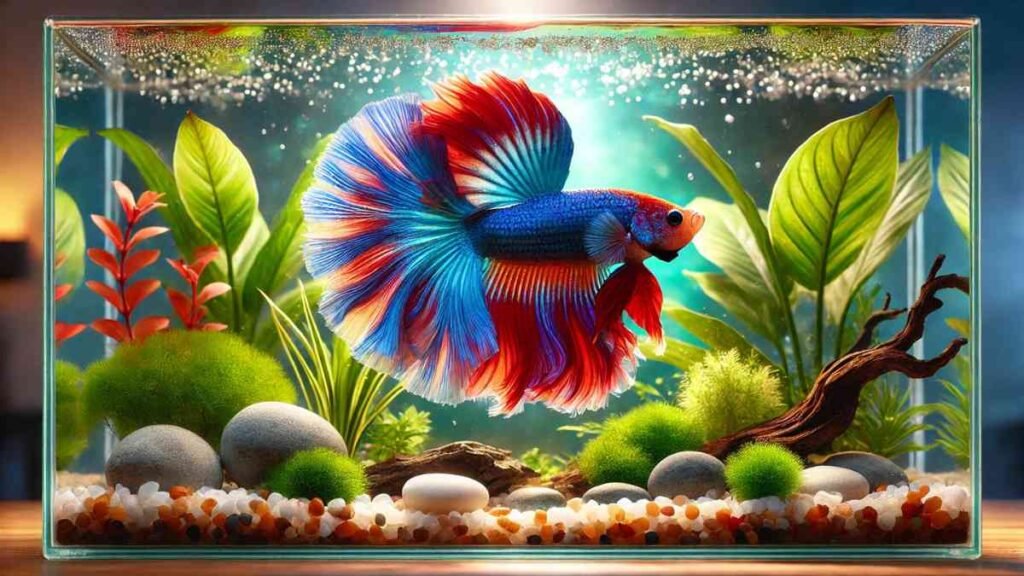Introduction
Beautiful betta fish, also known as Siamese fighting fish, captivate aquarium enthusiasts with their vivid colors, flowing fins, and dynamic personalities. Originating from Southeast Asia, these fish have become a symbol of elegance and resilience in aquariums worldwide. Whether you are a beginner or an experienced aquarist, understanding their characteristics, care needs, and breeding intricacies can enhance your enjoyment of these aquatic wonders.
The Diverse Types of Betta Fish
Veiltail Betta
The veiltail is one of the most common types of betta fish. Its long, flowing tail elegantly trails behind as it swims, making it a favorite among hobbyists.
Crowntail Betta
Known for their spiky, crown-like fins, crowntail bettas are strikingly unique. Their dramatic appearance makes them a standout addition to any aquarium.
Halfmoon Betta
Halfmoon bettas boast a tail that spreads to a perfect 180-degree arc, resembling a half-moon. This type is especially popular among breeders and competitive shows.
Double Tail Betta
Double tail bettas feature a rare genetic trait that results in two distinct tail lobes. These fish often have a more robust body and larger dorsal fin.
Plakat Betta
Plakat bettas resemble wild bettas with their shorter fins and athletic build. Despite their simplicity, their vibrant colors and feisty temperament make them highly sought after.
Dumbo Ear Betta
Named for their oversized pectoral fins resembling elephant ears, dumbo ear bettas add a whimsical charm to any tank.
The Vibrant Colors of Betta Fish
Solid Colors
- Red Betta Fish: Symbolizing passion and energy.
- Blue Betta Fish: Representing calm and serenity.
- White Betta Fish: Elegant and pure.
Iridescent Colors
- Turquoise and Green: Metallic hues that shimmer under light.
- Dragon Scales: Thick, metallic-like patterns.
Patterns
- Marble Betta: Ever-changing patterns that vary with time.
- Butterfly Betta: Contrasting fin colors with a clear division.
Essential Care Tips for Beautiful Betta Fish
Tank Setup
- Tank Size: A minimum of 5 gallons is ideal for a single betta fish.
- Water Temperature: Maintain a range between 76-82°F (24-28°C).
- Filtration: Use a gentle filter to keep water clean without creating strong currents.
- Decorations: Include live plants, caves, and hiding spots to mimic their natural habitat.
Feeding
- Diet: Provide high-quality betta pellets as a staple diet, supplemented with live or frozen treats like bloodworms and brine shrimp.
- Feeding Frequency: Feed small portions 2-3 times daily to avoid overfeeding.
Water Quality
- pH Levels: Keep pH between 6.5 and 7.5.
- Regular Maintenance: Perform weekly water changes of 25-30% to maintain cleanliness.
- Avoid Chlorine: Use a water conditioner to neutralize harmful chemicals.
Understanding Betta Behavior
Male vs. Female Bettas
- Males: Territorial and aggressive, especially towards other males.
- Females: Less aggressive and can sometimes coexist in groups called sororities, provided there is ample space.
Bubble Nest Building
Male bettas create bubble nests on the water’s surface as part of their breeding ritual. This behavior is a sign of a healthy and happy fish.
Breeding Betta Fish
Steps for Successful Breeding
- Choose a Pair: Select a healthy male and female with desirable traits.
- Prepare the Tank: Set up a breeding tank with shallow water, plants, and a hiding spot for the female.
- Introduce the Pair: Allow them to acclimate in separate sections of the tank before introducing them.
- Observe the Courtship: The male will flare his fins and build a bubble nest. The female should display vertical stripes, indicating readiness.
- Egg Laying and Fertilization: The pair will embrace, and the male will collect eggs in the bubble nest.
- Care for the Fry: Remove the female post-spawning and feed the fry infusoria or baby brine shrimp once they hatch.
Common Health Issues in Betta Fish
Fin Rot
- Symptoms: Frayed or discolored fins.
- Treatment: Improve water quality and use antifungal medication.
Ich (White Spot Disease)
- Symptoms: White spots on the body and fins.
- Treatment: Gradually increase water temperature and use ich-specific medication.
Swim Bladder Disorder
- Symptoms: Difficulty swimming or floating.
- Treatment: Fast the fish for 24-48 hours, then feed peeled, boiled peas.
Why Betta Fish Are Perfect Pets
Betta fish are ideal for both beginners and seasoned aquarists due to their:
- Low Maintenance: Requiring minimal effort compared to other pets.
- Stunning Appearance: Adding vibrant beauty to any home or office.
- Engaging Personality: Interactive and entertaining behaviors.
Conclusion
Beautiful betta fish are more than just stunning visual additions to an aquarium. With proper care, they thrive and bring joy to their owners. Whether you admire their vibrant colors, intricate fin shapes, or spirited personalities, betta fish are a testament to the wonder of aquatic life. By following the tips in this guide, you can ensure a healthy and harmonious environment for your betta fish.
For More Visit, Mirrormagazine.co.uk


